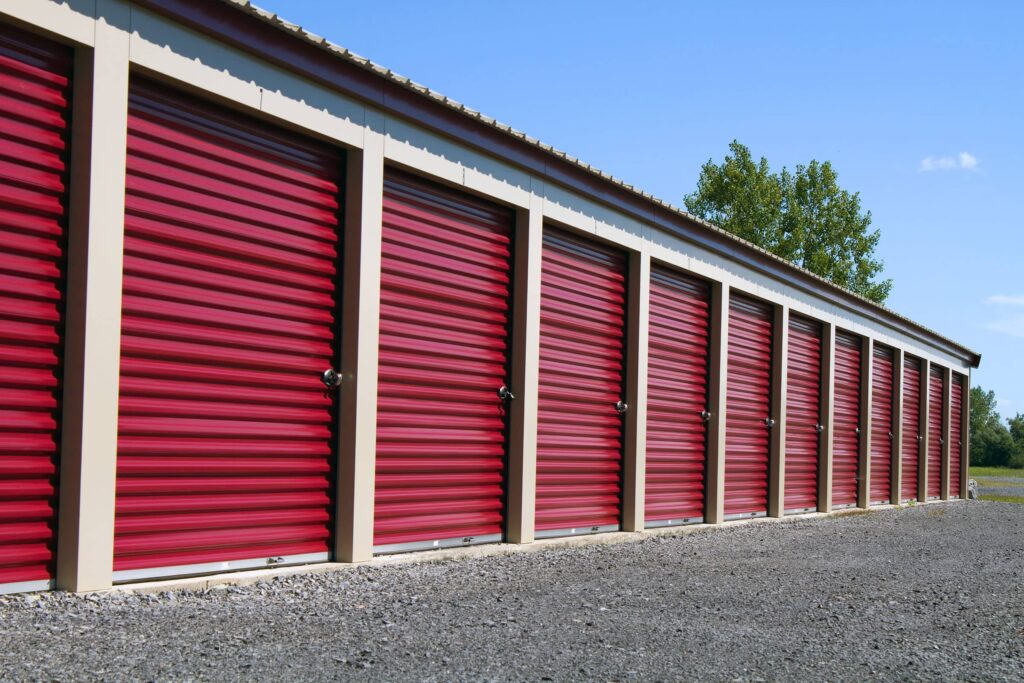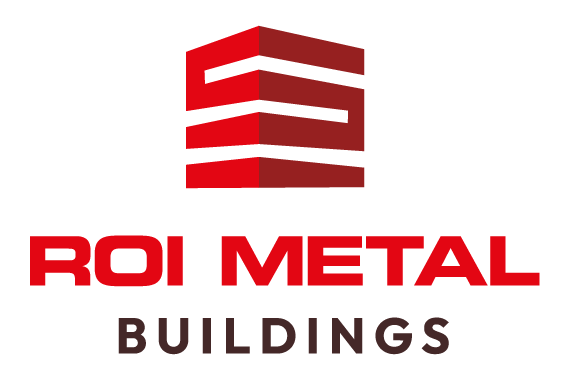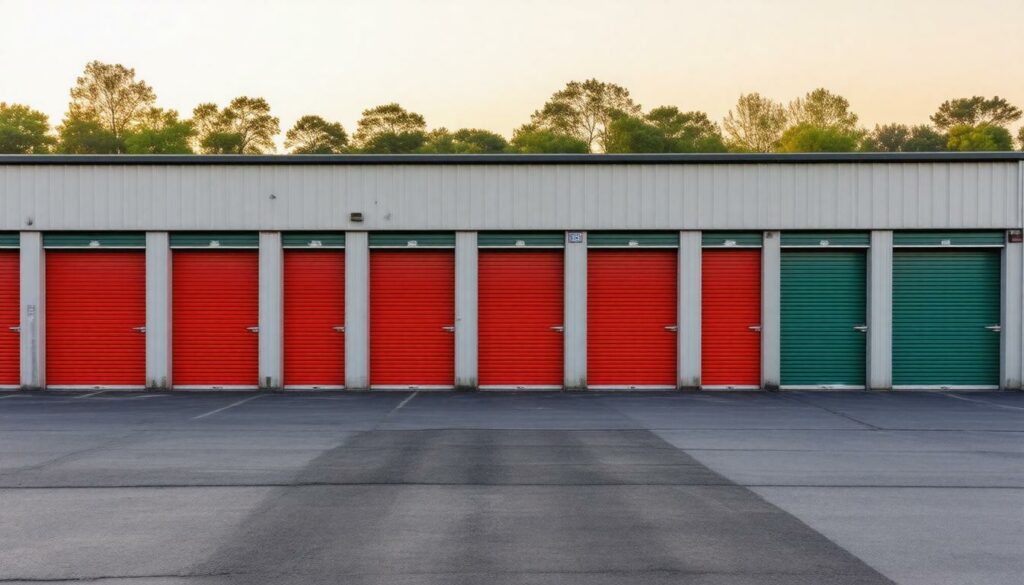When it comes to self-storage, the right door can make all the difference. It’s not just about keeping your belongings safe; a quality door can enhance accessibility and optimize your space. With so many options out there—from roll-up to swing doors—understanding which one fits your needs is crucial. In my experience working with storage facilities, I’ve seen firsthand how choosing the wrong door can lead to headaches, extra costs, and unhappy customers. In this guide, we’ll walk through choosing the right self-storage door for your facility. Let’s get started!
When choosing the right self-storage door, consider key factors such as local wind load requirements to ensure safety during storms, the ease of installation to minimize downtime, and the durability of materials like galvanized steel that can withstand heavy use. Additionally, evaluate warranty options and long-term maintenance considerations to make an informed decision that balances initial costs with future expenses.

How to Choose the Right Self-Storage Door: Types and Tips
Roll-up doors are incredibly popular for their space-saving capabilities. These doors roll up into a compact drum above the opening, meaning they don’t swing out and consume valuable space. This design allows you to maximize your storage area inside the unit. Additionally, roll-up doors are designed to withstand frequent opening and closing, ensuring their durability and reliable operation over time. Companies like Janus International and Trac-Rite manufacture several models tailored to different needs. For instance, Trac-Rite’s 944 series is frequently lauded for its durability and ease of operation, making it an excellent choice for facilities expecting heavy use. Beyond their functionality, roll-up doors are often made from robust materials like galvanized steel, ensuring longevity even in harsh environments.
It’s also important to ensure enough room in storage units for safe door operation and accessibility, preventing hazards in tight spaces.
While roll-up doors may fit many scenarios, there are other options worth exploring as well.
Swing Doors present another viable option for self-storage facilities. These doors operate similarly to typical household doors — they can swing either outward or inward based on design choices. However, they do require additional clearance space compared to roll-up variants, which may limit your overall storage capacity. Unlike traditional doors, swing doors need more room for operation, which can be a drawback in areas with limited space. Swing doors tend to be a favored choice in residential environments or facilities where space isn’t as much of a concern. Their reliability is enhanced by solid construction materials and traditional lock systems that ensure security without unnecessary complexity.
If you’re contemplating alternatives for tighter spaces, sliding doors could be the answer.
Sliding Doors may not be as conventional, but they offer a unique solution for environments with limited overhead clearance. Unlike their swing counterparts, sliding doors move horizontally along tracks, making them particularly useful in tight areas where traditional swinging motions would cause logistical challenges. Made often from lightweight metals or fiberglass, sliding doors can provide easy access while maintaining good security features. Sliding doors are particularly beneficial in tight spaces due to their compact design, which does not require extra room for operation. When considering sliding doors, choosing high-quality tracks is crucial to avoid issues with misalignment over time.
Each type of door brings its own set of benefits and considerations; understanding these differences can significantly simplify your decision-making process when selecting self-storage solutions.
For any storage facility owner looking to optimize their operations and enhance customer experience, a thorough understanding of self-storage door types will pave the way for smarter investments in durability and security features down the line.
With these options laid out, we can now focus on how material quality influences durability and safety in self-storage solutions.
Introduction to Self-Storage Facility
A self-storage facility is a crucial investment for individuals and businesses looking to store their belongings securely. When it comes to self-storage facilities, one of the most important aspects to consider is the type of door used for each storage unit. Self-storage unit doors come in various types, including roll-up doors, swing doors, and garage doors, each with its unique advantages and disadvantages. Understanding the different types of doors and their features is essential for making an informed decision when choosing a self-storage facility. Self-storage customers prioritize security features, and the right door can provide enhanced security against potential break-ins. A clear understanding of the different door types and their benefits can help individuals and businesses make the most of their self-storage experience.
Roll Up Doors and Options
Roll-up doors are a popular choice for self-storage facilities due to their space efficiency and robust construction. They are designed to roll up into a compact coil, providing easy access to the storage unit while minimizing the amount of space required for the door to open. Roll-up doors are available in various materials, including steel and aluminum, and can be customized to meet specific needs, such as advanced locking mechanisms and insulation. When choosing a roll-up door, it’s essential to consider factors such as durability, security features, and energy efficiency. Proper installation is also crucial to ensure smooth operation and minimal maintenance. Roll-up doors are an excellent option for self-storage facilities, offering a reliable and secure solution for storing belongings.
Alternative Door Options
In addition to roll-up doors, there are other alternative door options available for self-storage facilities, including swing doors and garage doors. Swing doors are a traditional choice and offer easy access to the storage unit, but they require additional space to open and may not be as secure as roll-up doors. On the other hand, garage doors are a more robust option and can provide enhanced security features, but they may require more maintenance than roll-up doors. When choosing an alternative door option, it’s essential to consider factors such as security, maintenance, and aesthetic appeal. Each door type has its unique advantages and disadvantages, and understanding these differences can help individuals and businesses make an informed decision when choosing a self-storage facility.
Durability and Security of Materials
When it comes to choosing the right self-storage door, understanding the materials involved is critical for both durability and security. Each material has unique properties that can significantly influence not only how long the door lasts but also how well it protects the contents behind it. As you weigh your options, let’s take a closer look at some of the most common materials.
Galvanized Steel
First on our list is galvanized steel, which stands tall due to its unparalleled resilience against rust and wear. Galvanized steel doors can withstand harsh weather conditions, making them ideal for various environments. Doors made from this material are particularly favored in settings that demand durability, like self-storage facilities. Take, for instance, the Model 750 from Janus International; it’s made specifically to withstand heavy usage and challenging weather conditions. Studies show that galvanized steel doors can last for up to 30 years with proper maintenance. Given their strength, they also provide an excellent barrier against forced entry, making them a solid choice for protecting stored items.
Aluminum
Next up is aluminum. While it may not boast the same level of durability as galvanized steel, aluminum doors do hold their own in specific environments. They’re lightweight and have excellent corrosion resistance, making them suitable for areas where harsh weather isn’t a concern. However, when it comes to security against forced entry, aluminum doesn’t quite measure up to steel. Yet don’t lose hope—integrating high-quality locking mechanisms can help alleviate some of those security concerns, making aluminum a viable option if appropriately secured.
Wood
Now, let’s turn our attention to wood. Though known for its aesthetic appeal, wood is generally not a favorable choice for self-storage applications due to its vulnerability to moisture and pests. A wooden door can deteriorate more quickly than its metal counterparts, leading to potential issues down the road—think rotting or warping that weakens structural integrity over time. If you find yourself drawn to wood for its beauty, be prepared for regular maintenance and possible replacement sooner than expected.
Choosing the right material impacts the door’s resistance to environmental factors; therefore, it’s essential to consider how various aspects of your location influence your selection process.
Climate and Environmental Factors
The geographical location of your self-storage unit plays a crucial role in determining the right type of door for optimal performance. A space situated in a coastal area, for instance, will face different environmental challenges compared to one in the arid interior. Therefore, you must carefully consider how climate can affect both your storage doors and your stored items over time. Choosing the right door material can protect stored items from environmental factors, ensuring their integrity and longevity.
Wind Load Requirements
In certain regions, mainly coastal or tornado-prone areas, it becomes vital to choose wind-load-rated doors. These doors are crafted to withstand high winds and prevent damage during storms.
Tools like the DASMA Wind Load Calculator provide valuable guidance on selecting appropriate door designs based on local conditions. If you’re considering options, Janus’s Model 850 is a stellar choice due to its certification for extreme conditions, such as those found in Miami-Dade County. Adhering to wind load regulations protects your investment and ensures the safety of the contents inside.
Humidity Considerations
Another aspect that significantly influences door selection is humidity levels. In areas with higher moisture levels, installing insulated doors might seem appealing at first glance. However, insulation can become a double-edged sword if it traps humidity inside, leading to corrosion of metal components and the growth of mildew on stored items.
Rather than insulated doors, consider vented options that allow for adequate airflow and moisture management. Such solutions maintain the integrity of your stored items and can extend the lifespan of your doors.
Temperature Variations
Temperature extremes can also dictate your door choice. In regions where temperatures fluctuate dramatically—either soaring above 100°F or plunging below freezing—thermal insulation becomes essential for maintaining a stable internal environment. Insulated doors help regulate temperature fluctuations within the storage unit, protecting sensitive items like electronics or wooden furniture from warping or damage caused by thermal shock.
Investing in quality insulated doors is wise if you live in an area prone to such extremes.
Recognizing these vital factors sets the stage for understanding other features that can enhance functionality and security within your self-storage facility.
Essential Additional Features
When investing in self-storage doors, considering additional features can truly make a difference in the experience for both you and your customers. One feature that stands out is the locking mechanism. While traditional cylinder locks might seem basic, they come with a host of advantages. Many industry professionals advocate for these locks due to their reliability, affordability, and ease of replacement. Additionally, electronic locks offer a modern security solution with keyless entry and remote control features, significantly enhancing security by reducing unauthorized access and providing reliable protection tailored to the value of stored items.
Unlike complex smart locks—which may offer advanced features but can also pose technical challenges—cylinder locks excel in providing simple, robust security that most people find reassuring. Their dependability ensures that customers have peace of mind knowing their belongings are protected.
Beyond just security measures, the operational aspects of a self-storage facility also play a critical role in attracting tenants.
Noise Reduction
One often overlooked feature is noise reduction capabilities. Imagine your customers arriving at a storage facility where the background hum of sliding doors and rollers clangs against metal all around them. It’s not exactly welcoming, is it? That’s where noise-dampening rollers and tracks come into play.
These components minimize operational sounds, thereby enhancing the overall customer experience. A quieter environment not only makes everyday operations more pleasant for everyone but can also help retain clients who appreciate a peaceful atmosphere when accessing their belongings.
Of course, the efficiency of installation cannot be ignored—especially if you wish to maximize your return on investment.
Ease of Installation
The ease of installation is another vital aspect of choosing self-storage doors. A quick installation means less downtime for your facility, which can translate to money saved and increased customer satisfaction. For example, opting for doors designed for speedy assembly can drastically improve your operational efficiency. Let’s take Janus’s Model 650 as an example; its design allows it to be installed in just five minutes!
This kind of time-saving feature benefits operators by minimizing disruptions while gaining access to immediate service capabilities.
Lastly, there’s one more element that often influences decision-making: cost.
Evaluating these essential additional features—like locking mechanisms, noise reduction technologies, and ease of installation—can greatly influence not just your personal convenience but also the entire client experience at your self-storage facility. Thoughtfully considering these aspects will help you meet customer expectations while maintaining efficient operations.
With these essential considerations in mind, it’s time to explore options that fit within budget constraints while still offering quality and functionality.
Installation Process and Requirements
The installation process for self-storage doors requires careful consideration to ensure proper installation and minimal maintenance. Accurate measurements are crucial to ensure that the door fits the storage unit correctly, and additional clearance should be considered to ensure smooth operation. The installation process typically involves assembling the door frame, installing the door, and securing it to the storage unit. It’s essential to follow the manufacturer’s instructions and consider factors such as durability, security features, and energy efficiency when installing the door. Proper installation can help prevent repairs and ensure that the door operates smoothly, providing a secure and convenient storage solution for self-storage customers. By understanding the installation process and requirements, individuals and businesses can make an informed decision when choosing a self-storage facility and ensure that their belongings are stored securely.
Budget-Friendly Options
When you’re in the market for self-storage doors, it can be tempting to go for the lowest price available. However, opting for cheaper alternatives often leads to unforeseen expenses and diminished effectiveness over time. Instead, consider budget-friendly options that offer a strong balance between cost and durability. Rolling doors are a cost-effective choice as they roll into a compact coil, optimizing space and functionality. This means looking for alternatives that might not be top-shelf but still perform reliably without breaking the bank.
For instance, used or refurbished doors can be an excellent way to save money—these choices can sometimes cut costs by up to 50%. But before you make a purchase, ensure sturdiness and function by checking the condition of components like hinges and locks. They might have some wear and tear, but often these products come at deeper discounts because they are still highly operational.
Price Ranges for Self-Storage Doors
- Roll-up doors, typically ranging between $300 and $800, provide a practical solution. While there might be concerns about weather resistance, many models come equipped with essential features even at this price point.
- Swing doors offer another economical option with prices generally between $200 and $600. Ensure you assess their suitability against your facility’s unique requirements.
- Don’t overlook steel doors, which may have an initial cost averaging from $500 to $1,200 but can serve multiple needs over the years with minimal maintenance.
“Investing wisely sometimes means securing higher-end doors that will stand the test of time and ensure long-term savings.”
It’s also vital to consider installation costs which can add an extra $100 to $300. While this isn’t negligible, proper installation is essential for optimal performance and longevity. During your budgeting phase, assess whether you can handle installation in-house; this could save additional costs while ensuring everything meets your specific standards.
Making these thoughtful choices as you work within a budget sets a clear foundation for future investments that uphold both fiscal responsibility and quality assurance. Now, let’s explore how to align door selections with specific facility needs and operational requirements.
Matching Door to Facility Requirements
Your facility’s requirements play a vital role in determining which self-storage door will work best for you. An integrated system of features, including advanced locking mechanisms and efficient space utilization, can significantly enhance the functionality of storage doors. Consideration of multiple factors ensures that the selected door not only functions optimally but also enhances the overall customer experience.
Whether you operate a small storage facility or a sprawling complex, understanding these requirements can help reinforce your operational efficiency while meeting customer expectations.
Door Size and Configuration
One of the most fundamental aspects of choosing the right door is ensuring that it accurately fits your storage units. Each storage unit may have different dimensions, so standard-sized doors might struggle to provide adequate coverage in certain cases.
In situations where non-standard openings are present, custom-sized doors become a necessity, as they ensure a snug fit and optimal performance. A poorly fitting door can let pests in or create security vulnerabilities, which no operator wants. Always measure twice, then choose wisely!
When I helped a friend who owned a storage facility tailor the sizes of his doors for his specific needs, he reported significant improvements in both security and user satisfaction—customers appreciated their spacious access.
Traffic Patterns
Another key factor to consider is the expected traffic patterns at your facility. If you’re running a high-traffic self-storage location, your choice of door should prioritize durability.
Look for doors designed with reinforced edges and those with high cycle rates; both features help withstand the rigors of frequent use without compromising on performance. After all, if customers are in and out quickly, you want a door that maintains smooth operation with minimal downtime.
A quick tip: Analyze peak usage times—this will inform your decision on selecting door types. Is rush hour happening every afternoon? Opt for roll-up doors that facilitate swifter entry and exit.
Having explored essential aspects like door size and expected traffic patterns, your next steps in this decision-making process will involve weighing specific options against each other. The path forward will require careful consideration of various factors to find the perfect match for your storage facility’s needs.
Making the Final Choice
Making the right choice in selecting a self-storage door is not just about matching it to specific requirements; it also requires careful consideration of various elements that will affect your facility’s overall operational efficiency. Choosing the right door for self storage units is crucial, as it enhances both security and convenience while optimizing limited space.
A comprehensive decision-making process should start by reflecting on your budget. While it may be tempting to opt for the cheapest option, it’s crucial to weigh this against potential long-term maintenance costs. Choosing a durable material like galvanized steel might require a higher initial investment, but it could save you money in repairs down the line.
Here’s a checklist that encapsulates the key considerations:
- Assess your budget constraints: Always remember that upfront costs are just part of the equation.
- Evaluate the environmental conditions: Each geographic area carries its unique challenges that should influence your decision.
- Consider expected traffic and usage: Think about how frequently customers will use the doors, stressing the importance of durability and ease of operation.
- Review additional features: Optional enhancements like reinforced frames or electronic access controls can significantly benefit your facility.
Take, for instance, a storage facility located near the coast, where severe storms are common. It would make sense for such an operation to prioritize wind-load-rated galvanized steel doors with robust locks to ensure safety and security. Insulation could be less critical in this scenario since it may lead to humidity issues, causing further complications down the line. The focus here is practicality; choosing doors specifically engineered for rocky environments tends to prolong their lifespan and function predictably under stress.
Ultimately, taking the time to think through these components allows you to choose a self-storage door that not only aligns with your current needs but also supports future growth and operational demands. Your facility’s success rests on investments made wisely today, so navigate carefully and wisely as you finalize your selection.
To explore high-quality door options tailored specifically to your requirements, visit ROI Metal Buildings or call us at 865-316-9009.
FAQ
How does the type of door affect security for my stored belongings?
The type of door significantly impacts the security of your stored belongings as it acts as the primary barrier against unauthorized access. For instance, roll-up doors provide robust strength and are often made from heavy-duty steel, making them more resistant to break-ins compared to traditional swing doors. By choosing the right door, customers can gain access to exclusive security features that offer enhanced protection. According to security assessments, facilities with roll-up doors report 30% fewer theft incidents compared to those with less secure door types. Additionally, features like solid locks and reinforced frames further enhance security, ensuring better protection for your valuables.
Are there specific types of doors that are better suited for climate-controlled storage units?
Yes, for climate-controlled storage units, insulated roll-up doors or insulated sectional doors are typically better suited. These types of doors provide excellent thermal efficiency, helping to maintain consistent temperature and humidity levels inside the unit, which is crucial for protecting sensitive items like electronics and antiques. According to industry studies, properly insulated doors can reduce energy costs by up to 30%, making them not only a practical choice but also an economical one for climate-controlled facilities.
Can I modify or upgrade my self-storage unit's door after renting it?
Yes, you can modify or upgrade your self-storage unit’s door after renting it, but this typically requires approval from the storage facility management. Many facilities prioritize security and uniformity, so modifications could violate lease agreements. According to a survey by the Self Storage Association, 68% of facility managers reported that unauthorized modifications can lead to additional fees or termination of the lease. Always check with your provider to avoid complications.
What factors should I consider when selecting a self-storage door material?
When selecting a self-storage door material, consider durability, security, insulation, and cost-effectiveness. Steel doors offer robust security and are resistant to wear and tear, making them ideal for high-traffic facilities—statistics show that steel doors can reduce break-in attempts by up to 60%. Alternatively, if climate control is important for your stored items, insulated doors can help maintain stable temperatures, reducing the risk of damage to sensitive belongings. Always balance these factors with your budget to ensure you make a well-informed decision.
What sizes do self-storage doors come in, and how do I determine what size I need?
Self-storage doors typically come in sizes such as 5×5 feet, 10×10 feet, 10×20 feet, and larger options, suitable for varying needs from small furniture to entire households. To determine the size you need, consider the items you’ll store; a standard 10×10 door can accommodate a one-bedroom apartment’s worth of belongings, while larger units like a 10×20 can fit multiple rooms or larger vehicles. It’s crucial to measure your items and opt for slightly more space than calculated, as studies show that renters often underestimate their storage needs by about 30%.




